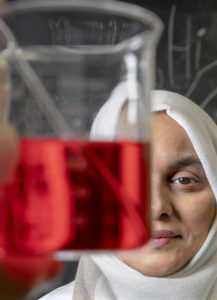Dr. Noureen Siraj has never been afraid of difficult research questions. Her interest in science first began when a chemistry professor gave a talk at the University of Karachi in Pakistan. She was so inspired by his speech that she wanted him to be her mentor at Graz University of Technology in Austria. This is when she started her research journey. After completing her doctorate, she joined Isiah M. Warner at LSU as a postdoctoral researcher and was later promoted to research associate. While pursuing her postdoctorate, he gave her the freedom to vocalize her ideas, even if she wasn’t sure if they would be successful.
“He’s the one who put so much confidence in me,” Siraj said.
This freedom allowed her to experiment with new ideas and ask new questions. Even if she didn’t feel those ideas would pan out, he allowed her to experiment in the laboratory and see what would transpire. Because even if her research ideas failed, she was able to formulate new research questions that she never thought about before. Now as a chemistry professor at UA Little Rock, Siraj is formulating new research ideas in materials science. This field combines chemistry, physics, and engineering to create novel and innovative devices and materials.
Thanks to a nearly $190,000 grant from the National Science Foundation, Siraj is studying experimental methods for developing organic optoelectronic materials. Optoelectronics are electronic devices that absorb and emit light,such as solar panels, LED lights, and solar fuelcells. Typically, these devices are created using silicon, which requires vast amounts of energy to produce and is restrictive in size.
Siraj is developing novel ionic materials, salts with a low melting point, to apply to optoelectronic devices. These materials offer a compelling alternative to silicon. The ionic materials with the Förster Resonance Energy Transfer, or FRET, process are very novel. FRET is a radiation-free energy transfer process between chemical compounds. Using this radiation-free process allows Siraj to create ionic materials that can be used for numerous optoelectronic applications in new ways.
The idea for this project began when Siraj worked with energy relay dyes for solar cell applications.
As she was brainstorming different ways to increase the efficiency of the solar cells, she started playing around with the idea of using the FRET process to develop promising new materials. FRET would allow them to create one compound instead of two, which greatly lowers manufacturing costs to create these devices. Instead of using multiple compounds to improve solar cell efficiency, this FRET process would allow her to use one compound to significantly improve the device’s performance.
She discovered she could use this compound and the nanomaterial not only for solar cells, but for organic light emitting diodes (OLEDS) and even photodynamic therapy, a form of medical treatment that uses light to generate singlet oxygen light that can kill unwelcome cells like cancer.
“That is the beauty of this project,” Siraj said. “We are using one single step reaction to synthesize the compound; we are not using multi-step. And the by-product is not very difficult to remove. We are not using an expensive technique to remove the by-product. So it makes the ionic material a very special material.”
With this funding, Siraj is traveling to the Georgia Institute of Technology Center of Organic Photonics and Electronics and Laser Dynamic Laboratory to use their advanced thin film and device fabrication equipment. This lab is a premier research center that specializes in electronic devices and flexible solar cells for information technology, telecommunications, and defense sectors. Siraj will synthesize the ionic materials at UA Little Rock, and begin advanced characterization of the ionic material at the Georgia Institute of Technology. Siraj plans to share the knowledge she’s learned at GIT with students and faculty at UA Little Rock.
Just like her mentor, Siraj is using her knowledge to teach and inspire high school and college students who are interested in chemistry to propose new research ideas and experiment in the lab. Recently, Siraj mentored Maghana Bollimpalli, a Central High School student who wants to research renewable energy. This research helped her earn more than $60,000 in scholarships. By raising up a new generation of researchers and scientists, Siraj is inspiring students to freely develop compelling new ideas and watch their work come to life in the lab.
This project is sponsored by the National Science Foundation under Award Number 1833004. Any opinions, findings, and conclusions or recommendations expressed in this material are those of the author(s) and do not necessarily reflect the views of the National Science Foundation.
